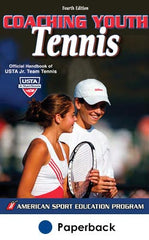Backhand Ground Stroke Drill ' The Lob
This is an excerpt from Coaching Youth Tennis - 4th Edition by American Sport Education Program.
To have your players practice backhand ground strokes, divide them into groups of four, with two players positioned at each service line. To begin the drill, one player from one of the groups drop feeds a foam ball over the net using a backhand ground stroke and immediately moves out of the way so that a partner can be ready to hit the return shot. One of the players on the opposite line returns the ball using a backhand ground stroke and also moves out of the way so that a partner can then be ready to return the ball when it comes back. Players continue to alternate and hit crosscourt backhand ground strokes until they have made 20 consecutive hits. At that point they move back to a position between the service line and baseline and hit until they have hit 20 consecutive crosscourt backhand ground strokes using low-compression balls. At that point they move back to the baseline for 20 consecutive crosscourt backhand ground strokes using regular tennis balls.
Lob
A lob is a shot that travels high over the net, bounces in the opponent's court, and travels over the opposite baseline. It can be a defensive shot when a player is pulled out of the court or is well behind the baseline and the opponent is in an offensive net position. The defensive lob serves two purposes: It gives a player time to recover to a better position on the court, and it forces the opponent away from the net to play a less offensive shot. The lob can also be played as a more offensive shot when a player is on or behind the baseline but has time to get set.
When preparing to hit a lob, the player assumes a ready position behind the center mark (see figure 7.21a). The ready position is a balanced body position in which the feet are about shoulder-width apart with the knees flexed and the back straight. The player's weight is forward with the feet and body facing toward the opponent, and the player's eyes are fixed on the ball. The racket should be held loosely between the waist and shoulders using a forehand grip. The weight of the racket should be supported in the nondominant hand, which is positioned near the throat of the racket. Once the opponent strikes the ball and the player determines the direction of the shot, the player initiates a unit turn in which he releases the racket with his nondominant hand and his body, racket, and feet all turn sideways to the net at the same time to face the forehand or backhand side (see figure 7.21b for an example of a unit turn to the forehand side). After the turn, the player should move immediately to the contact point where the ball will be hit. Ideally, the player will be in a good position before the ball lands on the court and will have time to take a few quick, short adjustment steps if necessary. While moving into position to hit the ball, the player should take the racket back so it points to the back and below the contact point, allowing it to move in a low-to-high swing pattern. The player's weight should be loaded on the back foot.
The forward motion then begins with a step toward the net with the front foot, transferring the player's weight from the back to the front foot (see figure 7.21c). At the same time, the racket swings from below the contact point to the contact point, which is in front of the forward foot and about head height, with the hitting arm fully extended. The nondominant arm stays back, and the body remains facing sideways on contact (see figure 7.21d). For the lob, the racket face will be open at the contact point to make the ball travel up off the strings. The open racket face will cause the ball to go up (see figure 7.21e), with the apex of the lob ideally aligning over the net. The racket will finish over the head with the hand at about eye height (see figure 7.21f).
Ideally, the player will set and load on the back foot so he can drive forward and rotate his body toward the net. This is often not possible because he is on the move even at the point of contact. If this is the case, the player must still swing from low to high and make contact with an open racket face to get the ball up and over the opponent. The farther the player is from the center mark, the higher he should hit the lob to create more time to recover into a better court position. Even if the lob is short, the opponent will not have an easy shot if the player at the baseline can return to a good ready position behind the center mark and be ready for the shot.


Get the latest insights with regular newsletters, plus periodic product information and special insider offers.
JOIN NOW


